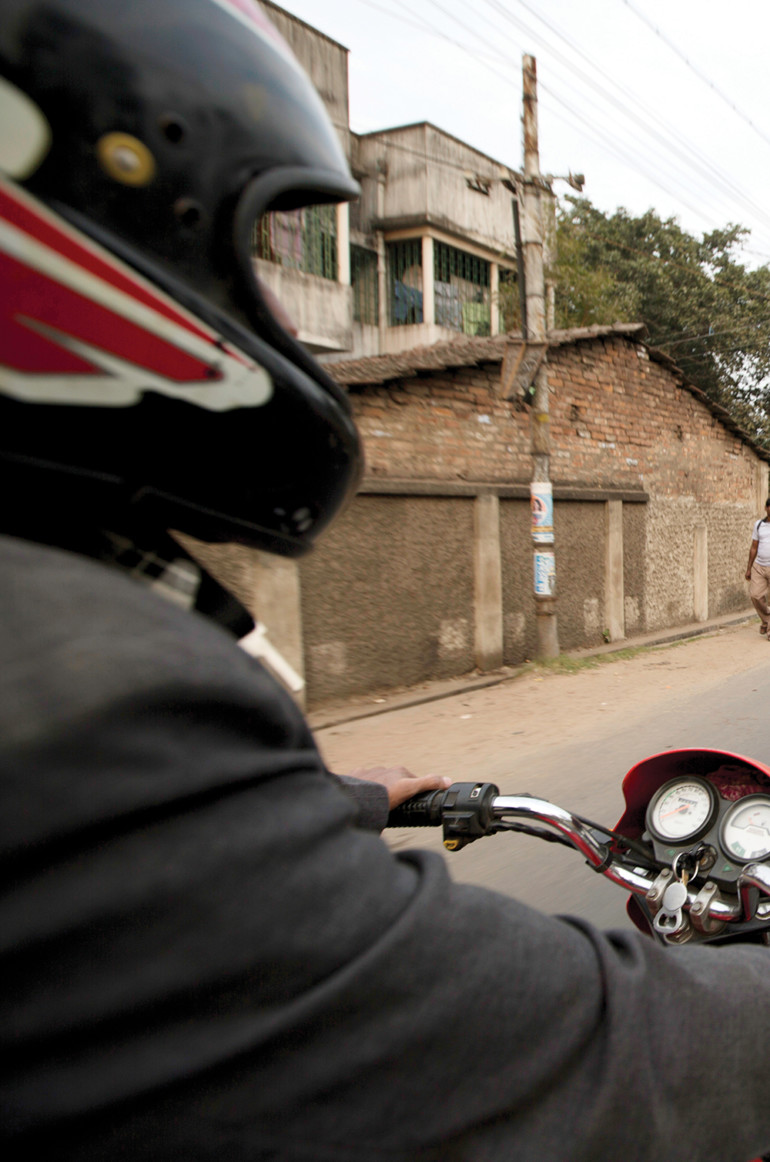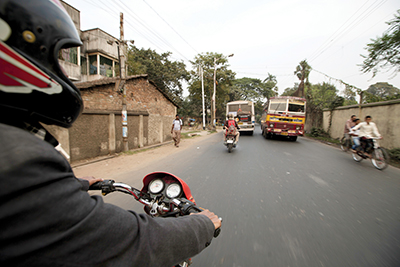 THE MOTORBIKE JOLTS forward. Adrenaline bursts into my bloodstream and I grab the closest available anchor, my bony-shouldered driver, Ujjal. Before I have time to rethink what’s starting to feel like an unnecessary risk, we barrel down the narrow city street at speeds usually reserved for highways, darting right and then left and then careening forward.
THE MOTORBIKE JOLTS forward. Adrenaline bursts into my bloodstream and I grab the closest available anchor, my bony-shouldered driver, Ujjal. Before I have time to rethink what’s starting to feel like an unnecessary risk, we barrel down the narrow city street at speeds usually reserved for highways, darting right and then left and then careening forward.
My eyes water at the blast of dust and air. Ujjal confidently threads the bike through the fray, only slowing when we hit a snarl of taxis, buses and tuk-tuks (auto-rickshaws). We push through slivers of roadway, bumping up against vehicles on all sides, the front wheel of the motorbike wedging forward until there’s nowhere left to go. We stutter to an abrupt stop.
Red light.
A chorus of revving engines surrounds us. I release my vise grip on Ujjal. As I suck in a ragged breath, more engine exhaust than air, it dawns on me that this is probably the best way to experience India. Not traveling by train or car or foot, but strapped on the back of a rocket being steered by a speed demon roughly half my age. Taking the risk. Living precariously. A fitting mode of travel in a country that, from my first impressions, thrives on relentless forward thrust.
Engines roar around us, revving like we’re queued at the start line of the Grand Prix. I seize the back of my seat. My stomach flip-flops.
Three. Two. One …
The light turns green. The motorbike bucks under us. I cinch my scarf over my grin, grab onto Ujjal, and we gallop off at a full sprint.
MY HUSBAND AND I PLANNED THE MOTORBIKE tour long before ever seeing the streets of India. It was one of the few tours we scheduled before leaving on our three-week trip, a first visit to India for both of us. By the time we hit Kolkata, a week in, we had become as wary of guided tours as we were of the congested roadways. All the guides we had hired thus far had led us straight to the worst of the infamous India touts instead of helping us avoid them. But we made the motorbike tour reservations through a well-known, well-reviewed company called Backpackers and decided to give it a chance.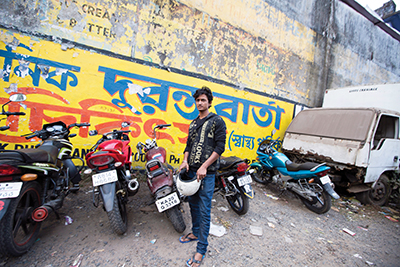
When we arrived at the office near Sudder Street in Kolkata, Rajesh, one of the company’s three founders, put us at ease immediately by offering us chai and a warm welcome, despite our excessive tardiness (we got lost, and then the cab driver got lost). He introduced us to our “riders” and informed us the tour would last approximately seven hours.
We balked. Apparently we hadn’t read the description very closely; we’d thought it would be more like three. Too late to change our minds now.
We walked to the bikes, small Yamahas. The company also offers rides on Royal Enfield bikes — a former British label now produced in India and the oldest motorcycle brand still in production — but our riders chose the smaller motorbikes for this trip. Strapping on my helmet, I climbed on the back and fumbled around for some kind of seat belt — something to strap me onto the bike. No dice.
“How do I keep from falling off?” I asked Rajesh.
“You won’t fall off,” he said in broken but mostly-understandable English. “Actually, you might. But you won’t fall hard. Don’t worry.”
He nodded at Ujjal. “If he starts going too fast, just give him a tap on the shoulder.”
I nearly asked why Rajesh didn’t say the same thing to my husband’s driver. But as we started whizzing down the street, heart stamping against my chest, I knew the answer. My driver likes to go fast.
WE DASH ACROSS THE CITY, WIND SLAPPING AT OUR bodies, the road a blur, inches away from our feet, fearinduced smiles plastered to our faces. Ujjal and the other driver slow to a stop in front of an inconspicuous gray building beside a busy overpass.
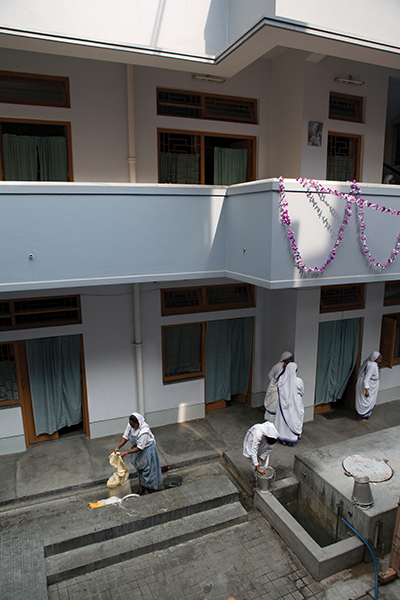 “You go see now,” Ujjal says, nodding to the building.
“You go see now,” Ujjal says, nodding to the building.
I tug my helmet off and disembark, legs wobbly on the pavement, and proceed toward the entrance with caution, eying two nuns seated on a bench next to the door. Our first stop is the “Motherhouse,” a volunteer center and pilgrimage destination where Mother Teresa lived and worked among Kolkata’s poor from the 1950s until her death in 1997. Part of the building has been converted into a museum and viewing area for Mother Teresa’s tomb. After you’ve seen the Taj Mahal, this tomb feels downright barren: a sparse room with folding chairs lining the walls, plain white sarcophagus at its center adorned with a scattering of bright flower petals.
Visitors also have an opportunity to see the room where Mother Teresa lived and worked for more than 50 years. As I peer inside the austere space — barely big enough to fit a chair, desk and bed — I consider the poverty I have witnessed so far in Kolkata, which although improved since Mother Teresa’s time remains blatant and dire in many parts of the city. It’s easy to feel crushed by seeing such destitution. Too overwhelmed to act. Although not without her critics, Mother Teresa dove in, as have many in her footsteps. I walk out of the Motherhouse inspired to do the same.
But for the time being, I have a single goal: make it to the end of my motorbike tour in one piece. Ujjal waits on the sidewalk, cellphone at his ear. He puts it away when he sees me returning.
“Next,” he says, helping me strap my helmet back on, “we see Kali Temple, OK?”
I nod. “You’re the boss.”
He punts the kickstand and we take off.
OUTSIDE THE KALI TEMPLE WALLS IN KALIGHAT, vendors hawk their wares: snaking garlands of orange and yellow flowers, intricately woven tapestries and tables stocked with brightly colored fruits and vegetables. Inside, hordes of locals line up to offer prayers at the altar of the goddess Kali. Ujjal leads the way, navigating the crowds in the same way he does the streets: without hesitation, pushing his way through the beggars and faux priests, their palms outstretched in the hopes of a handout. I follow his lead, trying my best to ignore the constant clamor of touts.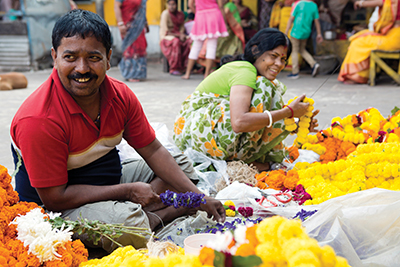
“Every Thursday and Saturday, many families come,” Ujjal says. He turns to my husband. “For this part, no photos.”
He takes off toward the heart of the temple, motioning for us to follow. I begin to hear drums. Goats bleating. A chorus of voices, shouting. The closer we get to the temple’s core, the louder it gets. I feel something slippery under my feet and look down to see the floor of the temple covered in a slick of blood. My heart pounds with the beat of the drums as we approach a wide cage surrounded by crowds of people. Ujjal pushes me toward the bars of the cage. Inside, two men are strapping a goat’s neck onto a wooden block. Another man, who’s holding a machete dripping with blood, pours a glass of liquid over the goat.
“Do you smell the whiskey?” Ujjal says.
I breathe in, nearly choking on the stench of whiskey and blood.
“Uh huh,” I say, holding my hand over my mouth.
“Watch, now!” he says, excitedly.
I might be sick. But I can’t look away. The drums quicken. The goat screams. The crowd bellows. The man raises the machete over his head and brings it down. Hard, on the goat’s neck. The goat’s eyes go wide, as if surprised. Tongue lolling out. Two men toss the goat by its hind legs and its body slams against the wall. The men dip their fingers into the goat’s blood and mark their foreheads. The body of the goat is dragged off to where, Ujjal says, it will be cooked and eaten by the family who brought it.
I’m still shaken by the image of the beheaded goat as Ujjal leads us back to the motorbikes. Hinduism doesn’t shy from the more brutal side of life and death. Later, I learn that Kali is one of the most bloodthirsty of the Hindu goddesses. The goat sacrifices are meant to (temporarily, at least) quench her thirst and bring bounty to families who participate in the ritual.
I clamor onto the motorbike, eager to get the image of the goat out of my head and clear the stench of blood from my nostrils.
DESPITE THE SEEMINGLY ENDLESS CITYSCAPE, IT TAKES only around 20 minutes to escape Kolkata’s traffic and wander into the countryside. Riding into the city’s outskirts, surrounded by fields of vegetable crops — cauliflower, eggplant, mustard — we bump along a pothole-filled road next to a blackened river that reeks of sewage. We pass rows of huts, farmers working the fields, piles of burning brush. Ten minutes up the road, Ujjal points to an enormous mound in the distance, a mass of birds swarming over it. I can barely see through the hazy smog.
“Garbage Mountain,” he says.
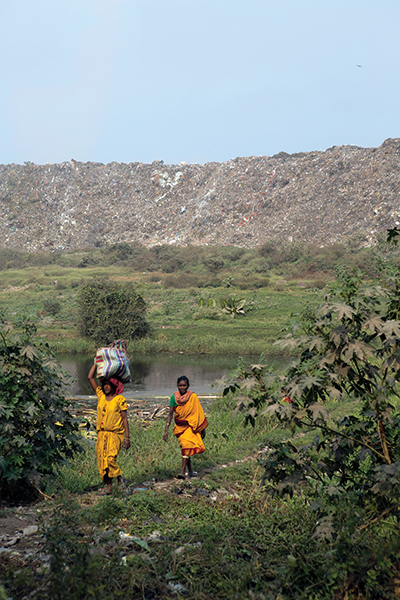 Garbage Mountain, as the locals call it, is Kolkata’s dump. The pile of trash takes up approximately 10 square kilometers and attracts thousands, who spend their days picking through the city’s refuse looking for plastic, glass and other recyclables. On our way back to the city, we pass the area where this recycling is processed, including wide quilts of crushed plastic shards splayed out beside the road in an array of bright colors that will eventually be melted down and re-formed.
Garbage Mountain, as the locals call it, is Kolkata’s dump. The pile of trash takes up approximately 10 square kilometers and attracts thousands, who spend their days picking through the city’s refuse looking for plastic, glass and other recyclables. On our way back to the city, we pass the area where this recycling is processed, including wide quilts of crushed plastic shards splayed out beside the road in an array of bright colors that will eventually be melted down and re-formed.
From the countryside, we traverse the city again and cross the Vidyasagar Setu, which takes us over the slategray Hooghly River into the city of Howrah. We stop for an authentic Bengali lunch at a streetside joint, where we shovel mounds of spicy rice, dal (lentils) and fried fish with our fingers into our mouths, washing it all down with bottles of warm Coca-Cola.
Rejuvenated, we hit the road at full speed again, making our way through Kolkata’s version of Chinatown toward a vast botanical garden, where we dismount the bikes for long enough to walk off our lunch. It doesn’t take us long to reach the centerpiece of this garden, the Great Banyan, lauded as one of the oldest and largest living trees on earth.
The tree feels more like a forest, each root dangling down from its blanketing canopy big enough to be a separate trunk, some so big I wouldn’t be able to reach both arms around. When I put my arm out to touch one of the roots, Ujjal stops me before my fingers hit the plant.
“No touching,” he says. “You pay lots of money.”
Although it appears plenty sturdy, the 250-year-old tree has been ravaged by monsoons. The park sets strict rules to prevent visitors from disrupting the fragile ecology of its root system. I take a minute before we go to enjoy a rare moment of peace and quiet under the protective canopy. Doing my best to carry that experience with me, I re-mount the motorbike and we take off toward our next destination, the Mullik Ghat flower market.
WE PULL INTO A DARK AND GRITTY ARMPIT UNDER the southeast end of the Howrah Bridge, where rows of vendors sit cross-legged, baskets of flowers displayed in front of them. The petals pop against their drab backdrop. Golds, yellows, oranges, reds.
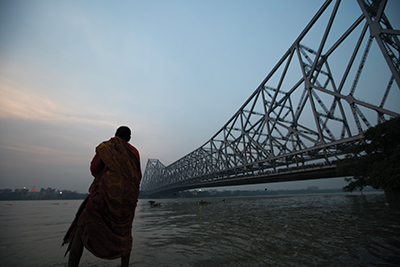
Howrah Bridge.
Eager buyers browse and haggle, likely looking to brighten whatever the next festive occasion may be, such as a wedding or other religious ceremony (both easy to find in India, especially in December). A loamy smell fills the air as we push deeper into the market. Each alley we turn into offers new explosions of color, a seemingly endless floral labyrinth. I try on an intricate crown made of flowers, one of the more expensive items sold here, made to be worn by the bride and groom at a wedding.
Not far from the flower market, we stop by a few of the ghats lining the Hooghly River. A ghat is simply an entrance or walkway of steps leading to a body of water, usually a holy river. The first ghat we visit is a bathing ghat. Here, people come to dunk in the river and bathe, or drink, or pray.
The second ghat we visit is called a burning ghat, where wealthy Hindus pay to have their loved ones cremated on a burning pyre. The cremation ritual is meant to help release the soul from its human body in order for it to be purified and eventually reincarnated.
Standing off to one side, we watch the dark outline of a body burn on a heap of wood, smoke rising up as the relatives watch from rows of nearby benches.
“See the head?” Ujjal says.
I see it. I try not to breathe too deep, avoiding the smell of burning hair and flesh. Ujjal explains that, depending on how big the body is, the burning ceremony can take anywhere from two to six hours.
“Very expensive,” Ujjal says.
An open-air funeral pyre can cost a family an entire month’s wages. Many opt for the much cheaper electric cremation.
Back on the motorbike, the fresh air streaming up my nostrils helps clear away the smell of death. I welcome the rush of energy I feel coursing through my system and savor the feeling of being alive.
BY THE TIME WE ROLL INTO KUMORTULI, THE POTTERY and sculpting quarter of Kolkata, the sky has darkened. Rows of brightly lit shops line a dingy, narrow road, each one overflowing with clay statues of Hindu idols, some brightly painted and others not painted at all. Some half finished. Others complete. Some enormous, taller than me, and others the size of my palm.
One artist, a gray-haired man squatting as he sculpts a lifesize clay bust in front of his studio, barely looks up as I ogle the elaborate detail of his handiwork. Another shows me how he creates rows of identical Ganesh statues, using a mold to form the clay into the shape of the well-known elephant-headed god. The larger idols have a frame inside, covered by a layer of straw and then covered with clay before they are finally painted.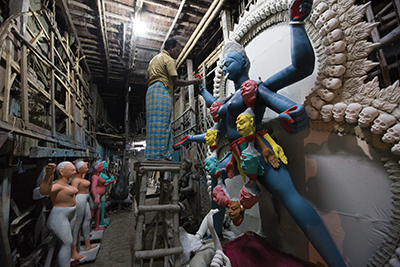
Ujjal says these statues will be featured in temples and religious festivals throughout the area. We had just missed the Durga Puja festival, one of the biggest of the year (which takes place in early October and features the many-armed Hindu goddess Durga). I make a mental note to check the festival schedule next time I plan a visit.
We whisk off as the sky goes black, snaking our way back toward the bustle of downtown Kolkata. Ujjal has warned my husband and me that for this final part of the tour, we cannot take photos. We are heading for a neighborhood called Sonagachi, the red light district, home to an estimated 10,000 sex workers. The documentary film Born Into Brothels: Calcutta’s Red Light Kids turned a worldwide spotlight on the area when it won an Oscar for best documentary in 2005. Although prostitution is technically illegal in India, the trade flourishes in certain areas, like Sonagachi. As a result, sexually transmitted diseases like HIV and human trafficking have long been major issues for the city.
The roadway leading to the main drag looks like any other downtown Kolkata neighborhood: hectic, gritty, loud. Then I see the women. Masses of women, lining the streets. All shapes, sizes and colors. Many of them Indian, wearing saris, some with bleached blond hair. Some foreigners too. Women everywhere. They clog the streets, which have been reduced to a narrow pathway, their beckoning eyes aimed at the drivers on the road. Waiting for anyone to pull over.
But we’re not pulling over. Ujjal revs the engine and the motorbike breezes through the gauntlet.
Soon, the women of Sonagachi are behind us. The ghats are behind us. The beautiful banyan tree and the doomed goats at Kali Temple. The workers buzzing around Garbage Mountain and the inspiring Motherhouse. All behind us.
By the time we return to where we started, I’m exhausted. I step off of the bike feeling a mix of relief tinged with disappointment that the ride has ended. But mostly, I have an overwhelming sense of satisfaction in knowing that I saw parts of Kolkata I never knew existed. Not just the tourist parts. But the parts that make Kolkata real. The parts that make it multifaceted and unique. After such a ride, I can’t help but make a vow to come back.
Although motorbike tours are relatively common in countries where that mode of travel is preferred, the focus on non-tourist destinations made this one unique. The group that organized the excursion is called Backpackers, which also offers a recommended tour of the Sundarbans jungle. tourdesundarbans.com/kolkata-tour-motor-ride.php

